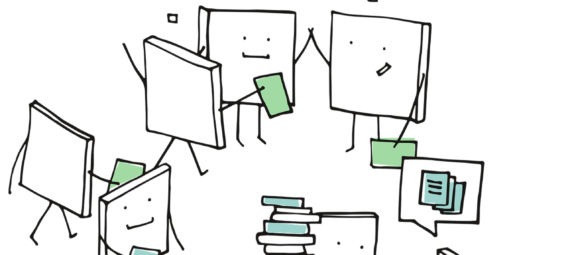The daily work routine when working from home looks different than in the office at university and also poses different challenges. One colleague’s child may be at home and is often interrupted at work as a result, another colleague feels like she has to respond even late at night when her supervisor writes an e-mail, another colleague withdraws completely and you don’t hear or see anything from him. What can you do to still work well together?
“The greatest honor you can do to a person is to have trust in him.”
Matthias Claudius
Trust is the key variable!
Your colleagues may be at home, but they still want to deliver good work results – you can and should assume this. Mutual trust creates motivation and recognition. And motivation and recognition create good work results!
Stay in contact
However, trust does not mean breaking off contact and everyone works quietly on their own. Even if you are at home – keep in touch. For most of us, exchange and cooperation is important – we draw energy and ideas from it and often achieve better work results when working together rather than alone. To do this, it can be helpful to set fixed appointments, for example a morning phone call, a regular video team meeting or similar. More frequent short meetings are more manageable for most people than less frequent long meetings. Shared rituals such as sharing a cup of coffee or tea, or even sharing pizza at lunchtime over a casual video exchange creates connection and brings you back better to shared goals at work. Try out what works best for your team and ask others how it works best for them, too.
If you hold a work meeting, save the results in written form. Everyone can then use these to continue working. At the end of this article, we listed several tools that can help you to collaborate digitally.
However, our communication is limited in digital contexts because the non-verbal nuances are missing. Therefore, also keep an eye on small signals from colleagues. Is something not going as it should? Does someone need support and someone else can help? What do your colleagues need for a good working relationship? Sometimes these are quite banal things, but they are fundamental. Therefore, try to create a foundation for teamwork, of being there for each other, through contact and mutual trust, even if you are not physically working together.
Choose your communication medium consciously: Some things don’t work well in written communication. For confidential and private conversations, face to face contact is essential. A video chat is the closest possibility to this, because at least you can see each other. But you have to consider: Perhaps the colleague is uncomfortable if you see his or her private background? Is there a possibility to meet in person in this case? For many, the face to face contact is very important for collaboration.
Tools for digital collaboration
There are several tools you can use for digital collaboration. Some are mentioned here and many more are explained by @LLZ.
MLUconf: You are probably familiar with MLU’s conferencing system by now. Instructions can be found at: WikiLLZ
MLUcloud: MLU’s cloud service to store files, work together and get access to all your files without network access.
padlet: A tool to collaborate digitally. You can use it as like a pinboard to e.g. collect meeting topics, but you can also share work assignments and results.
Meistertask: You have even more possibilities with Meistertask. Here you can manage your projects or simply structure team tasks and note who has already done what, what still needs to be done, etc….
The @LLZ wiki offers you information on many other tools and guides you step-by-step into digital collaboration: WikiLLZ
Further education offers:
You can find thematically suitable seminars (in German) around the topic of healthy collaboration by clicking on the following links:
- Führungswissen kompakt: Personalführung in Verwaltung und Wissenschaftsmanagement
- Führungswissen kompakt: Personalführung in der Wissenschaft
- Individual-Coaching für Beschäftigte und Führungskräfte
- Gemeinsam Lösungsstrategien entwickeln – Einführung in die Methode der kollegialen Beratung
Image credits: Manfred Steger (Pixabay)

